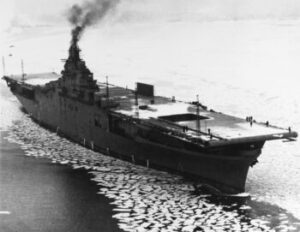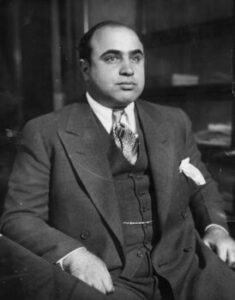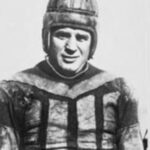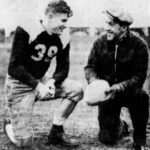This is one of those stories that you certainly can not make up: happiness, pride, tragedy, heroes, and gangsters all wrapped up in one unbelievable, but true story!
On this episode of “When Football Was Football” we’ll dip into our WWII files to share the remarkable exploits of a Medal of Honor winner, whose father turned out to be less than admirable. Or was he?
We remember one of America’s great, fallen heroes and his ever-lasting legacy to aviation. But how was he connected to the Chicago Cardinals?
Actually, this program was originally intended to be posted on a significant social media site, but was deleted for some reason.
It is difficult to understand how the story of an American hero might be offensive, but we do apologize in advance if the words you are about to hear might prove to be inappropriate. But somehow, we think that you’ll agree with us that this is a story that is indeed worth sharing!
Edward "Butch" O'Hare - American War Hero
In the dreary early days of WWII, pilot Edward “Butch” O’Hare became an instant hero in this country when he solely attacked a wave of nine enemy heavy bombers in the Pacific that were threatening his ship, the U.S.S. Lexington. The Chicago Herald American later wrote:
“The Chicagoan’s position was hopeless, suicidal, and, according to tactical experts, impossible of even delaying the attackers. O’Hare knew this, but dived toward the on-rushing formation.”

In the end, O’Hare shot down five enemy planes and damaged another thus assuring the safety of his ship. His actions were so brave and so effective that on April 21, 1942, President Franklin Roosevelt proudly presented O’Hare with the Medal of Honor for his noble actions. His Medal of Honor citation read as follows:
“For conspicuous gallantry and intrepidity in aerial combat, at grave risk of his life above and beyond the call of duty, as section leader and pilot of Fighting Squadron 3 on February 20, 1942. Having lost the assistance of his teammates, Lieutenant O’Hare interposed his fighter between his ship and an advancing enemy formation of 9 attacking twin-engine heavy bombers. Without hesitation, alone and unaided, he repeatedly attacked this enemy formation, at close range in the face of intense combined machine gun and cannon fire.
Despite this concentrated opposition, Lieutenant O’Hare, by his gallant and courageous action, his extremely skillful marksmanship in making the most of every shot of his limited amount of ammunition, shot down five enemy bombers and severely damaged a sixth before they reached the bomb release point. As a result of his gallant action—one of the most daring, if not the most daring, single action in the history of combat aviation—he undoubtedly saved his carrier from serious damage.”

What Was The Cardinal Connection?
So what was his connection to the Cardinals? In corporate papers from the Illinois Secretary of State’s office, Butch O’Hare’s father, also named Edward O’Hare, was listed as one of the directors of the Chicago Cardinals football team in the 1930s. The elder O’Hare was a well-known attorney, who dabbled in several other businesses, including being the partner of gangster Al Capone in the ownership of some dog and horse racing tracks. He was killed in an apparent mob “hit” in 1939 in Chicago.
The demise of Edward O’Hare remains one of the great mysteries in Chicagoland crime history. Who did it? Why did they do it? In fact, a notable Chicago judge, Eugene J. Holland, told the Chicago Daily News after the incident that he would be “shocked” if O’Hare was associated with gangsters. Still, the murder had all of the markings of a gangland hit as described by witness Peter Szent, who told the Daily News: “I looked around and saw two automobiles traveling northeast on Ogden Avenue. One car [O’Hare’s] was running parallel to the parkway.”
According to Szent, a second car followed closely and then pulled up next to O’Hare on his left. “The man on the right-hand side of the car was holding a shotgun with his right hand, his elbow braced on the frame of the car. He apparently was pulling the trigger with his left hand.” From such a close distance, O’Hare never had a chance and after he was mortally wounded, his car careened into a light pole and then ended up on some street car tracks.
Despite the apparent implications of being involved with the mob, O’Hare had once said: “You can make money through business associations with gangsters, and you’ll run no risk if you don’t associate with them personally.”
O’Hare managed to tip-toe around his business associates when he was president of Sportsman’s Park in Chicago, but apparently, his participation in the trial of Al Capone earlier in the decade was what prompted his death. The Herald-American reported in 1948 that “What none of the syndicate hoodlums knew until 1937 was that O’Hare had helped the government build its case against Capone.” As a result, Capone was convicted on tax evasion charges and reported to the Alcatraz prison in 1933.

O'Hare Family Legacy
In 1947, Frank J. Wilson, retired chief of the Secret Service, stated: “I had one of the best undercover men I have ever known in Eddie O’Hare.” However, once, the knowledge about the role that O’Hare played in the conviction of Capone began quietly circulating among the underworld, the planning for his murder on November 8, 1939, was put in motion.
As for his heroic son, Butch O’Hare was feted around the country for his bravery in 1942 but was anxious to return to action. As he told the Associated Press on April 6, 1942: “It will be a relief to get back to flying. Looking at machine guns isn’t nearly as bad as facing cameras!”
Butch O’Hare insisted on returning to the Pacific to do his part in defense of his country. On November 26, 1943, O’Hare was lost in aerial combat and neither he, nor his plane, was ever recovered. Once again, he selflessly and boldly attacked the enemy, preventing major damage to the U.S. fleet below. Rear Admiral Arthur W. Bradford said: “Butch, with accompanying planes, saved my formation from certain torpedo hits. I am recommending him for a second Medal of Honor.”
Although neither O’Hare, nor his plane, was ever found, the heroic son of a Chicago Cardinals’ officer will remain both a legacy and an inspiration into the future. And why is that?
To honor his memory as the first flying “Ace” of WWII, the tiny airport northwest of Chicago was renamed in his honor on September 19, 1949. There it remains today as O’Hare International Airport…
Please Share If You Enjoyed!!!
Author and Host - Joe Ziemba
Joe Ziemba is the host of this show, and he is an author of early football history in the city of Chicago. Here, you can learn more about Joe and When Football Was Football, including all of the episodes of the podcast.

Please Note – As an Amazon Associate I earn from qualifying purchases
Resources
More From When Football Was Football
Ugly Passers, Brick Walls, and Feisty Cardinals
Since the Arizona Cardinals are the NFL’s oldest team, with...
Read MoreThe NFL’s Forgotten Gold Medalist!
As usual during the staging of the Summer Olympics, numerous...
Read MorePaddy Driscoll’s Almost Perfect Season
Back at the beginning of the National Football League in...
Read More120,000 Fans Witness High School Football Game in 1937!!!
Let’s set the stage… It was a warm November afternoon...
Read More


